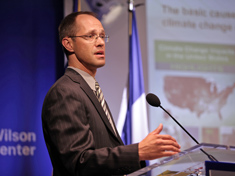-
Ian Kraucunas on Bridging the Science-Politics Divide for Climate Change
August 15, 2014 By Moses Jackson
“Climate change is not just a far-away thing that affects far-away people,” says Ian Kraucunas, deputy director of atmospheric sciences and global change at the Pacific Northwest National Laboratory in this week’s podcast. “It affects things people here in the U.S. care about – and, in fact, that includes national security.”
“Climate change is not just a far-away thing that affects far-away people,” says Ian Kraucunas, deputy director of atmospheric sciences and global change at the Pacific Northwest National Laboratory in this week’s podcast. “It affects things people here in the U.S. care about – and, in fact, that includes national security.”
Kraucunas participated in a symposium this summer hosted by the Henry M. Jackson Foundation and the Pacific Northwest National Laboratory in Seattle on ways to help leaders make more informed choices about climate and security risks.
The urgency of such risks is now well established, thanks in part to recent government reports like the National Climate Assessment, which Kraucunas calls a “pivot point in terms of communicating our understanding of climate change.”
Future climate change scenarios vary based on different modelling assumptions, including how humans will respond, but the gist is clear: things are bad and getting worse. “No science of climate change talk is complete without graphs of things going up and to the right,” says Kraucunas.
“No science of climate change talk is complete without graphs of things going up and to the right”But climate change is not a uniform process that affects all areas in the same way. Understanding regional dynamics is crucial to developing appropriate responses.
“In terms of sea-level rise, the entire world is not going up at the same rate,” Kraucunas says. Relative rates of sea-level rise are subject to local factors like coastal subsidence and ocean circulation patterns.
And while average precipitation is not expected to change much across the Pacific Northwest, for instance, Washington State will receive more of that precipitation in the form of rain rather than snow – with major implications in terms of hydropower production, flood control, salmon migration, and wildfires.
Extreme heat and flooding threaten national security by affecting the training, readiness, and infrastructure of military forces, Kraucunas says; for example the Hampton Roads area in Virginia and bases in the American Southwest are vulnerable.
Indirect climate-security impacts are more difficult to discern but no less important. “Clearly there are going to be impacts on food security,” he says, “but exactly how those are going to play out, where those are going to play out, and how frequently we’re going to see different types of food insecurity issues arise is really a healthy and active research area.”
Provide Context, Not Just Data
The military and security communities can help address climate change by reducing their own carbon footprint, says Kraucunas, and the scientific community can help by doing a better job translating science to policy. The “loading dock” approach of simply providing information en masse to decision-makers and leaving it to them to interpret just “isn’t that helpful.”
“It’s important to not just provide climate information in a vacuum”A more productive approach involves developing well-targeted information and putting it into context. This can be tricky, however – particularly since many security risks are indirect and multi-faceted. “You really have to understand how different systems interact with one another,” says Kraucunas. “It’s important to not just provide climate information in a vacuum.”
The Pacific Northwest National Laboratory, a national research institute managed by the U.S. Department of Energy, is addressing this concern by developing a range of data tools and modeling systems to address different aspects of climate change, including those relevant to national security. By examining the links between biophysical, climatological, hydrological, ecological, energy, and socio-economic systems, scientists at the lab hope to offer more constructive, actionable guidance to decision-makers, says Kraucunas.
For instance, mapping water supply and demand at the global level can provide useful information about macro-level water scarcity hotspots and trends, while higher-resolution modeling can illuminate how such trends play out at the local level.
“This function of bridging between the science community and the decision-making and stakeholder communities is one that really could use a lot more attention and a lot more expertise,” Kraucunas says. Bringing them together not only helps improves climate responses but also helps identify the issues that people care about most.
Kraucunas spoke at the Wilson Center on July 29. Download his slides to follow along.
Friday podcasts are also available for download on iTunes.
 A Publication of the Stimson Center.
A Publication of the Stimson Center.




